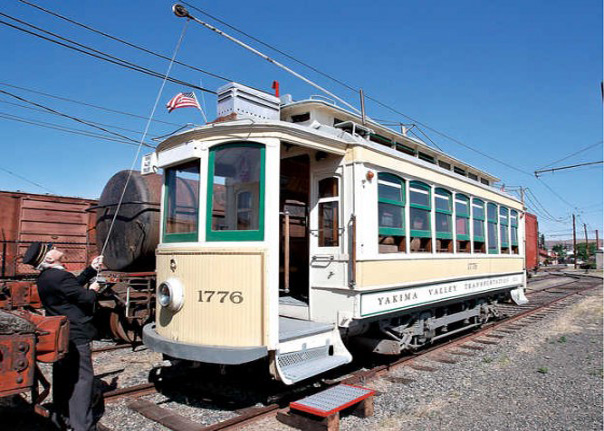Yakima Valley Transportation Lines
Status: Saved!
Year Listed: 1992
Location: Yakima Valley, Yakima County
In the late 19th and early 20th centuries, people were lured to Washington’s Yakima Valley to grow apples on 5-10 acre orchards which promised to produce wealthy independence in “the home of the prize red apple.· Private and public irrigation projects created hundreds of thousands of acres of fruit and by 1929 Yakima County had the largest number of bearing apple trees in all of Washington’s 39 counties and had become the statewide leader in apple production. Yakima County has ranked first in national apple production since 1930.
In order to get all of those apples to market, the Yakima Valley Transportation Company (YVT) built a 48-mile-long electric interurban railroad between 1907-1913. The line, started by local Yakima County people, stretched far west of Yakima and north to Selah. In 1908 it was bought out by the Oregon Railway and Navigation Company (today the Union Pacific). Over its lifetime there were 16 streetcars, six interurban passenger/express cars, three electric locomotives and Line Car A used to repair the wires. Passenger service lasted until 1947 and was brought back as a limited tourist operation in 1974. Electric freight operations continued non-stop until 1985 when Union Pacific decided to abandon the YVT.
By that time, it was the last authentic turn-of-the-century interurban electric railroad in the United States still operating. I remember the yellow electric locomotives hauling refrigerator cars of apples to market. The abandonment by the Union Pacific saw a donation of some of the YVT to the city of Yakima, but the following years saw removal of the YVT rail lines and involvement of the Washington Trust to sound the clarion call for its preservation before it was all gone. In 1989, the YVT was listed on the Washington Trust’s “10 Most Wanted” list, a precursor to our Most Endangered Places list. Thankfully, it has been saved, and in 1992 was listed on the National Register of Historic Places. In 1994, the late Les Tonkin, an architect and former president of the Washington Trust, devised a total restoration plan for the YVT.
Today the historic belt-operated shop/carbarn, powerhouse substation, and live of the original 48 miles of track remain connecting the cities of Yakima and Selah. Now more than a century old, the YVT is being operated by the non-profit passionate volunteer group Yakima Valley Trolleys and is passing on the love of the trolley to younger generations.





